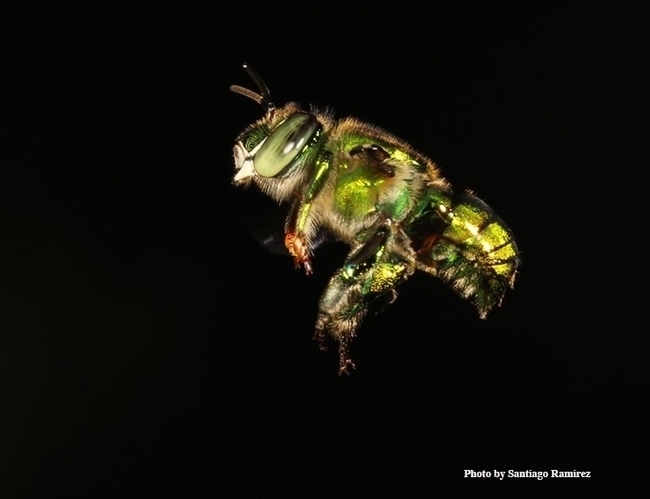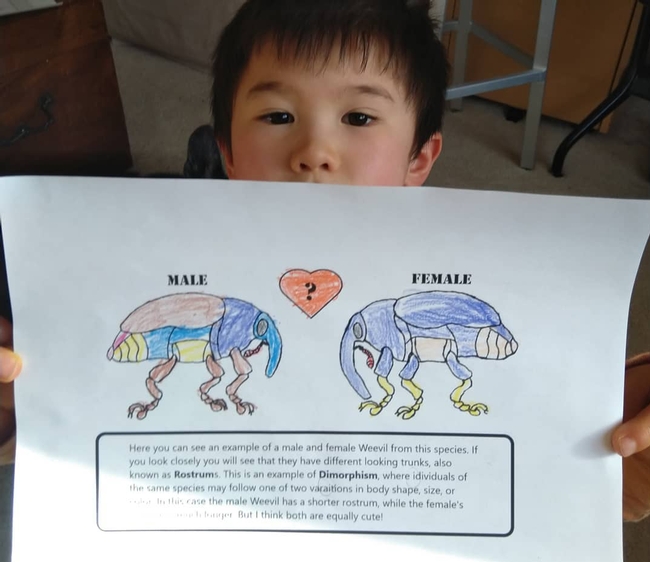
As part of the UC Davis Biodiversity Museum Month, the Santiago Ramirez lab, UC Davis Department of Evolution and Ecology, has created a 10-page Plant-Insect Interactions Coloring Book. If you access the pre-recorded programs activities section, you can download it for free, in either English or Spanish! (Or both!)
The coloring book is the work of Ramirez lab team members Molly Barber, Fernanda Guizar, Collin Gross and Jasen Liu. As you may know, Ramirez is a global expert on orchid bees (see Bug Squad blog) and a Chancellor's Fellow. His postdoctoral researcher Nick Saleh earlier presented a UC Davis Biodiversity Museum talk on the social behavior of bees, focusing on orchid bees.
But back to the coloring book. It's engaging. It's informative. It's entertaining. And it's a good opportunity to learn more about the science of plant-insect interactions and practice your coloring skills. You can stay within the lines or slip out a bit! It's your book!
The Ramirez team explains that orchids "are a big family with many, many plant species. Most of them have beautiful flowers that attract all kinds of pollinators. Some orchid flowers produce perfumes. The scent of these flowers attracts pollinators such as orchid bees. However, scent can also attract herbivores!"
For instance, the authors post an illustration of a weevil and explain: "This type of weevil is herbivorous, meaning it feeds on plant matter. Here you can see a weevil larva, the form the weevil takes just after they have hatched out of their egg. This larva is currently feeding on the inside of the Gongora orchid flower bud. Yummy!"
Another page: "Here you can see an example of a male and female weevil from this species. If you look closely, you will see that they have different looking trunks, also known as rostrums. This is an example of dimorphism, where individuals of the same species may follow one of two variations in body shape, size or color In this case, the male weevil has a shorter rostrum, while the female's rostrum is much larger. But I think both are equally cute!"
The authors point out that not all flowers reward their pollinators. They note that the California pipevine attracts fungus gnats by producing a smell similar to that of mushrooms.
You'll learn that flowers have "evolved ways to make sure that their pollinators are the only ones that can visit them. For example, nectar spurs (hollow modified petals) have evolved in many plant species that allow only pollinators with proper adaptations, such as long beaks or tongues, to reach the nectar at the bottom of the spurs."
Insects are the primary pollinators but they aren't the only ones. The authors draw attention to hummingbirds and bats. They provide an illustration of a Marcgravia. "The bats drink nectar from bowl-like nectaries hanging underneath the flowers and transfer pollen from their foreheads while they do so. The cup-shaped leaves above the flowers reflect the sonar of bats, allowing for them to easily hone in on the plants."
About UC Davis Biodiversity Museum Month
The 10th annual UC Davis Biodiversity Museum Month program is all virtual this year via live talks and demonstrations, and pre-recorded presentations. It's being celebrated throughout the month of February. The science-based event traditionally occurs on only one day--the Saturday of Presidents' Weekend, when families and friends gather on campus to learn first-hand about the UC Davis museums and collections. The 2020 event drew more than 4000 to the campus.
This year's biodiversity event is featuring 12 museums or collections:
- Anthropology Museum
- Arboretum and Public Garden
- Bohart Museum of Entomology
- Botanical Conservatory
- California Raptor Center
- Center for Plant Diversity
- Häagen-Dazs Honey Bee Haven
- Nematode Collection
- Marine Invertebrate Collection
- Museum of Wildlife and Fish Biology
- Paleontology Collection
- Phaff Yeast Culture Collection
For more information and the schedule, access these two formats on the UC Davis Biodiversity program website: (1) live talks and demonstrations and (2) pre-recorded talks and activities. Information on the biodiversity museum events also appear on social media, including Facebook, Instagram, and Twitter, @BioDivDay.
To help support the Biodiversity Museum event, contributions are being accepted through a month-long crowdfunding campaign program at https://crowdfund.ucdavis.edu/project/24310.
Attached Images:
